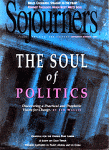1994 thus far has been a momentous summer. The ad-friendly Woodstock reunion is upon us, the impending (at the time of this writing) baseball strike is the talk of the sports world (replacing O.J. and the World Cup),
and rockers are testifying before congressional committees.
Grunge for Justice
n On August 13 and 14, all eyes (or so Pepsi-Cola would have us believe) will be pointed toward Saugerties, New York, a site 50 miles from the original Woodstock event. And the warm-up has been going on for years. Behind the scenes there have been struggles over product licensing (including the "official" event guitar—Martin, if you want to know), movie and soundtrack rights (Time Warner), and the actual site to use (the original spot just wasn’t good enough). But with all that now settled, the promoters can focus on the most important aspect of the event—the profit.
Tickets for this historic re-event were sold through Ticketmaster in bundles of four, with each ticket costing $135—plus the infamous service charge. Better yet, travel companies were selling packages that included airfare, sleeping accommodations, and a ticket. From the West Coast a fan could buy this package for $799. And to think that tickets to that first Woodstock were only $18 for three days of fun in the occasional sun.
This same $18 price became the battleline between two giants in the music industry this summer. Hotter-than-hot Seattle (where else?) grunge band Pearl Jam put the question of commercialism on the summer fanzine tour map of topics. Hoping to keep ticket prices more affordable, Pearl Jam dared to face up to the Beast of the musical apocalypse, Ticketmaster. With astonishing courage—and good marketing sense—this quintet has potentially tossed their future into the mosh pit by rocking the industry’s boat.
The issue for Pearl Jam was that they wanted to keep the price of a ticket below $20 for their summer tour. The price was set at $18, with the hope that Ticketmaster could live with a 10 percent markup. (Industry sources believed Pearl Jam could sell out its concerts even with ticket prices more than twice that.)
But Ticketmaster is not used to having suggestions made as to its profit margin. With near-monopoly control over venues and promoters, Ticketmaster is able to increase concert ticket prices about 45 percent. That $18 Pearl Jam ticket has become more than $26 in no time.
Well, Pearl Jam had had enough. The band jumped ship, planning to arrange its own concert tour, and filing a complaint with the Justice Department for anti-competitive practices in the ticket distribution industry. But when Ticketmaster threatened the major stages with lawsuits for breaking their exclusive contract, Pearl Jam found itself with limited options. Outdoor concerts (à la Woodstock) present security concerns, and high insurance rates.
Stone Gossard and Jeff Ament of Pearl Jam found themselves instead spending a sunny summer afternoon testifying before Congress about Ticketmaster’s monopolization of the concert industry.
I watched all this transpire with a good bit of interest. But it reminds me of my favorite saying (which I recently made up): When elephants wrestle, only the mice are crushed.
Just as is true in the baseball situation, neither side in the Ticketmaster skirmish arouses deep passion in me. Although my inclination is to support the laborers (in this case the musicians and their road crews), this is not a traditional labor dispute. The scale of their income does matter. The principles at stake may be similar, but they are affected by seven-digit perspectives.
It is difficult to work up a sweat to support millionaires—musicians or athletes—who are organized when most workers’ dreams and aspirations are being downscaled. In these cases, the aggrieved parties have access to the public through the media, but it’s the public and the less visible parties in their respective industries who lose if agreements can’t be reached.
So, though I wish Pearl Jam well and would look forward to greater competition in the concert industry, my passion has yet to be ignited. Woodstock was a foundational event in the development of the concert industry. It is the grandmother of all concerts. But this summer, it’s the legacy left by Woodstock II, of a tremendously commercialized music industry, that is most obvious. Pearl Jam, at least, seems to be trying to offer an alternative.
Oops
Last month in this space I reviewed the impressive recording of a new rock-and-roll band, Frente!. Unfortunately, while praising the lead singer of the band, I confused her name with that of an old friend. Angie Hart sings the lyrics for Frente!; the consistently mentioned (at least I’m consistent) Angie Hill is a name from the past. Sorry. I hope no one else has embarrassed themselves (as I have) because of this error.
DANNY DUNCAN COLLUM normally fills this space with wit and wisdom. He is on temporary respite, working on a book and finishing school work, but will soon be back. His return will be greatly appreciated, since he remembers the names of the singers he reviews.

Got something to say about what you're reading? We value your feedback!